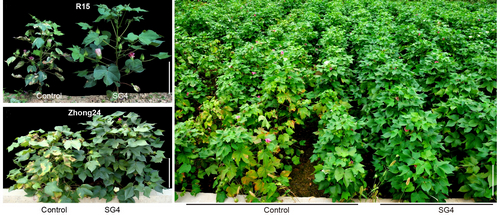Verticillium dahliae (V. dahliae) Kleb., as a destructive plant pathogen, causing vascular wilt diseases on more than 400 plant species, including many crops such as cotton, potato etc., and the annual global crop losses caused by this pathogen are estimated to reach over billions of dollars. It was firstly introduced to China through the importation of cotton seeds from the United States in 1930s. The acreage of Verticillium wilt infected cotton fields in China is around 2.5 million hectares annually, which is equivalent to ca. 50% of the cotton planting area in the country with direct economic losses of ca. 250-310 million U.S. dollars.
Gastrodia elata Bl. is a traditional Chinese medicinal herb with a recorded history of more than 1,000 years in China. Through the study of Gastrodia antifungal protein family, which is critical for the Gastrodia elata-Armillaria mellea symbiosis, scientists from CHU Chengcai’s group at the Institute of Genetics and Developmental Biology, Chinese Academy of Sciences, has brought GAFPs (also known as gastrodianin) into cotton, and they showed that GAFP4, one of the GAFP members, displays the strongest Verticillium wilt resistance.
In collobration of scientists from Chinese Agricultural Academy of Sciences, they further demonstrated the GAFP4 transgenic cotton greatly enhanced resistance to Verticillium wilt in the 3-year field trials of three different disease nurseries across China, and thus resulting in a significant 20.7% to 51.73% fiber yield increase.
The immense losses caused by V. dahliae make this pathogen the major obstacle to cotton production. However, disease control towards Verticillium wilt is extremely difficult. For one reason, V. dahliae is persistent in the soil, which can survive for more than 10 years even in the absence of hosts. For another, no fungicide so far is available to cure commercial upland cotton once infected by V. dahliae.
All attempts at breeding cultivars with high resistance to Verticillium wilt have not been successful so far, as according to Dr. CHU, “Breeding of broad-spectrum resistant cultivars is considered to be one of the most effective approaches. Unfortunately, the lack of genetic resources as well as effective target genes for use in genetic engineering strongly limited this breeding effort. Verticillium wilt is thus regarded as ‘the cancer of cotton’”.
“Insect-resistant cotton is currently one of the most widely grown genetically modified (GM) plants and the introduction of Bacillus thuringiensis (Bt) toxin gene effectively solved the harm of cotton boll worm. However, none of such powerful gene is deployed to date to prevent or cure cotton fungal diseases such as Verticillium wilt so far,” said Dr. WANG Yiqin , the first author of the paper, “our results suggest that GAFP4 is a powerful candidate for genetic engineering in control of cotton Verticillium wilt disease.”
This study entitled “
Significant Improvement of Cotton Verticillium Wilt Resistance by Manipulating the Expression of Gastrodia Antifungal Proteins” was just published online on July 1, 2016 in
Molecular Plant (
DOI:10.1016/j.molp.2016.06.013). This work is supported by grants from Transgenic Plant Research of the Ministry of Agriculture of China and National Natural Science Foundation of China.
GAFP4 transgenic cotton showed enhanced resistance to Verticillium wilt. R15 and Zhong24 are two upland cotton cultivars. SG4, GAFP4 transgenic cotton. (Image by IGDB)
Contact:
Dr. CHU Chengcai
 GAFP4 transgenic cotton showed enhanced resistance to Verticillium wilt. R15 and Zhong24 are two upland cotton cultivars. SG4, GAFP4 transgenic cotton. (Image by IGDB)Contact:Dr. CHU ChengcaiEmail: ccchu@genetics.ac.cn
GAFP4 transgenic cotton showed enhanced resistance to Verticillium wilt. R15 and Zhong24 are two upland cotton cultivars. SG4, GAFP4 transgenic cotton. (Image by IGDB)Contact:Dr. CHU ChengcaiEmail: ccchu@genetics.ac.cn CAS
CAS
 中文
中文




.png)
